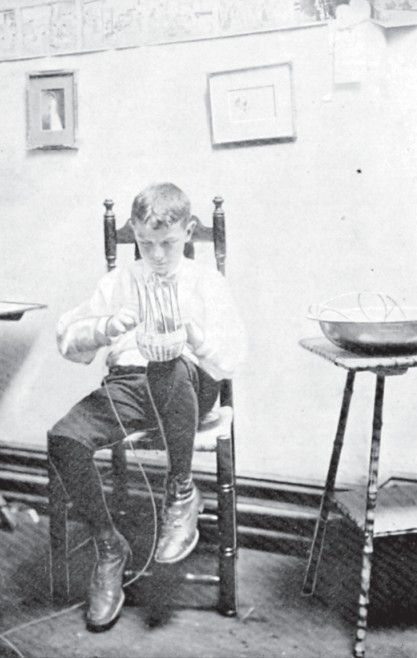| Web
and Book design,
Copyright, Kellscraft Studio 1999-2010 (Return to Web Text-ures) |
 (HOME)
|
| CHAPTER IV
THE SIMPLEST BASKETS IN weaving the first baskets, while the worker is getting familiar with his material, he should copy such simple forms as are shown in the plate. The working out of his own ideas will follow later.
Materials: 4 14-inch spokes of No. 3 rattan, 1 8-inch spoke of No. 3 rattan, 2 weavers of No 2 rattan.
Begin as in the directions for a mat, and when the centre or bottom of the basket is about two inches in diameter, wet the spokes and bend them sharply upward, remembering always that the side toward the person weaving is the outside of the basket, and that the weaving should go from left to right. This is something that even skillful young workmen sometimes need to have impressed upon them. The bottom of the basket should be placed on the knee with the side which in starting was toward the worker turned down, the spokes bent upward, and the weaving done in that position. In weaving up the sides of the basket, the middle finger of the right hand presses down each spoke behind which the weaver has to go, while the thumb and forefinger bring the weaver along behind it. Two weavers are used, and they are joined by simply crossing them, at an inch from the end of each, behind a spoke. After binding off, finish with Open Border No. 1.
Materials: 4 14-inch spokes of No. 3 rattan, 1 8-inch spoke of No. 3 rattan, 2 weavers of No. 2 rattan.
Having made a bottom about two inches in diameter, wet the spokes and turn them up, rounding them by bending them over the middle finger. The first weaver should not be drawn too tight, but allowed to go easily, though pressed closely down upon the weaving just below it. Before the middle of the second weaver is reached the spokes should be gradually drawn closer together by a slight tightening of the weaver; this should continue to the end of the weaver. Bind off and finish with Open Border No. 2. This is an important basket in teaching the effect of a loosely and a tightly drawn weaver. Both this basket and the one with straight sides make pretty candy baskets, especially when they are dyed or stained attractively; see Chapter XII.

WEAVING A SMALL BASKET This illustrates the way in which small baskets are held while weaving the sides.
Materials: 4 14-inch spokes of No. 4 rattan, 1 8-inch spoke of No. 4 rattan, 2 1/2 weavers of No. 2 rattan.
Any child who has successfully made the mats and baskets already described will be able to form this stand and it will interest him to see how useful it will be on someone's desk. After weaving a centre almost two and a quarter inches in diameter, the spokes are turned sharply upward, and the weaving of the sides is begun; this will be a little harder than the weaving of the first two baskets because the sides should be kept perfectly straight all the way up. To do this there must be an even pressure on the weaver, neither too tight nor too loose, and the spokes must be kept the same distance apart from the bottom to the top. The spoke material being heavier than in the other baskets helps to keep the sides firm. Two weavers and part of a third are used; the edge is then bound off and Open Border No. 1 finishes it. |